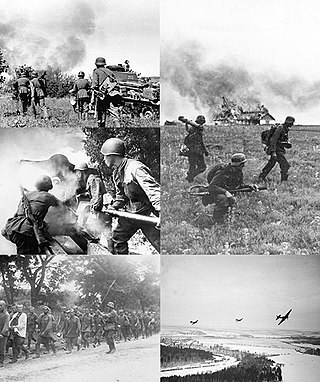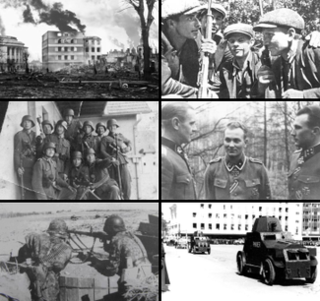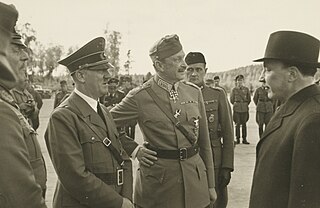
The Continuation War, also known as the Second Soviet-Finnish War, was a conflict fought by Finland and Nazi Germany against the Soviet Union during World War II. It began with a Finnish declaration of war on 25 June 1941 and ended on 19 September 1944 with the Moscow Armistice. The Soviet Union and Finland had previously fought the Winter War from 1939 to 1940, which ended with the Soviet failure to conquer Finland and the Moscow Peace Treaty. Numerous reasons have been proposed for the Finnish decision to invade, with regaining territory lost during the Winter War regarded as the most common. Other justifications for the conflict include Finnish President Risto Ryti's vision of a Greater Finland and Commander-in-Chief Carl Gustaf Emil Mannerheim's desire to annex East Karelia.

Operation Barbarossa was the invasion of the Soviet Union by Nazi Germany and many of its Axis allies, starting on Sunday, 22 June 1941, during World War II. It was the largest and costliest land offensive in human history, with around 10 million combatants taking part, and over 8 million casualties by the end of the operation.

The Axis powers, originally called the Rome–Berlin Axis and also Rome–Berlin–Tokyo Axis, was a military coalition that initiated World War II and fought against the Allies. Its principal members were Nazi Germany, Fascist Italy and the Empire of Japan. The Axis were united in their far-right positions and general opposition to the Allies, but otherwise lacked comparable coordination and ideological cohesion.
Co-belligerence is the waging of a war in cooperation against a common enemy with or without a military alliance. Generally, the term is used for cases where no formal treaty of alliance exists. Likewise, allies may not become co-belligerents in a war if a casus foederis invoking the alliance has not arisen. Co-belligerents are defined in the Encyclopaedic Dictionary of International Law as "states engaged in a conflict with a common enemy, whether in alliance with each other or not".

The Finnish Army is the land forces branch of the Finnish Defence Forces. The Finnish Army is divided into six branches: the infantry, field artillery, anti-aircraft artillery, engineers, signals, and materiel troops. The commander of the Finnish Army since 1 January 2022 is Lieutenant General Pasi Välimäki.

Operation Alphabet was an evacuation, authorised on 24 May 1940, of Allied troops from the harbour of Narvik in northern Norway marking the success of Operation Weserübung and the end of the Allied campaign in Norway during World War II. The evacuation was completed by 8 June.

The 169th Infantry Division was a German infantry division during World War II.

Finland participated in the Second World War initially in a defensive war against the Soviet Union, followed by another, this time offensive, war against the Soviet Union acting in concert with Nazi Germany and then finally fighting alongside the Allies against Germany.

The matter of German troop transfer through Finland and Sweden during World War II was one of the more controversial aspects of modern Nordic history beside Finland's co-belligerence with Nazi Germany in the Continuation War, and the export of Swedish iron ore during World War II.
The Ryti–Ribbentrop letter of agreement was a personal letter from President of Finland Risto Ryti to German Führer Adolf Hitler signed on 26 June 1944. It was sent during the Soviet Vyborg–Petrozavodsk Offensive, which had started on 9 June and threatened to knock Finland out of the Continuation War.

The 163rd Infantry Division was a German Army infantry division in World War II. Formed in November 1939, it was engaged in the invasion of Norway the following year. It fought alongside the Finnish Army during Operation Barbarossa against the Soviet Union. During this time, the division's transit through neutral Sweden caused the Midsummer Crisis of 1941. The division spent most of the war in Finland, before being returned to Germany. It was destroyed in March 1945 in Pomerania by the First Polish Army, subordinated to the Soviet 1st Belorussian Front.
The 289th Rifle Division was an infantry division of the Soviet Union's Red Army, formed twice. The division was first formed in the summer of 1941, after the German invasion of the Soviet Union, and was sent to the front and destroyed in the Battle of Kiev in September. The division was formed a second time in October 1941 from the 5th Rifle Brigade, a separate infantry brigade fighting in the Continuation War against Finnish and German troops in Karelia. The new division spent most of the war in Karelia and in the summer of 1944 fought in the Vyborg–Petrozavodsk Offensive, which resulted in the end of the Continuation War in September. The division was stationed at Belomorsk in Karelia until its disbandment after the end of World War II in July 1946.

Estonia declared neutrality at the outbreak of World War II (1939–1945), but the country was repeatedly contested, invaded and occupied, first by the Soviet Union in 1940, then by Nazi Germany in 1941, and ultimately reinvaded and reoccupied in 1944 by the Soviet Union.

The Erna long-range reconnaissance group was a Finnish Army unit of Estonian volunteers that fulfilled reconnaissance duties in Estonia behind Red Army lines during World War II. The unit was formed by Finnish military intelligence with the assistance of German military intelligence for reconnaissance operations.
The following outline is provided as an overview of and topical guide to World War II:
Einsatzkommando Finnland was a German paramilitary unit active in northern Finland and northern Norway during World War II, while Finland was fighting against the Soviet Union with the support of Nazi Germany. The official name of the unit was Einsatzkommando der Sicherheitspolizei und des SD beim AOK Norwegen, Befehlsstelle Finnland, but it was often referred to as Einsatzkommando Finnland.
The timeline of the occupation of the Baltic states lists key events in the military occupation of the three countries – Estonia, Latvia and Lithuania – by the Soviet Union and by Nazi Germany during World War II.

The Hitler and Mannerheim recording is a 1942 recording of a private conversation between German dictator Adolf Hitler, and Carl Gustaf Emil Mannerheim, Commander-in-Chief of the Finnish Defence Forces. It took place on a secret visit made to Finland by Hitler to honour Mannerheim's 75th birthday on 4 June 1942, during the Continuation War, a sub-theatre of World War II. Thor Damen, a sound engineer for the Finnish broadcaster Yleisradio (YLE) who had been assigned to record the official birthday proceedings, recorded the first eleven minutes of Hitler and Mannerheim's private conversation—without Hitler's knowledge. It is the only known recording of Hitler speaking in an unofficial tone.

Raising the Flag on the Three-Country Cairn is a historic photograph taken on 27 April 1945, which was the last day of the Second World War in Finland. It depicts a Finnish Army patrol of Battle Group Loimu, Infantry Regiment 1, raising the Finnish war flag on the three-country cairn between Norway, Sweden, and Finland. As the cairn was the westernmost point on the Finnish mainland, this symbolized that the last German troops were gone from Finland. The photograph was taken by the commander of Infantry Regiment 1, Colonel Väinö Oinonen. It became a widely circulated symbol of the end of World War II in Finland.

Salomon Klass was a captain in the Finnish Army, a company commander and one of the three Finnish Jews who were nominated to be awarded the Iron Cross by Nazi Germany during World War II, all of whom refused to accept it. He was also a Zionist and joined the Irgun in Palestine before the war.